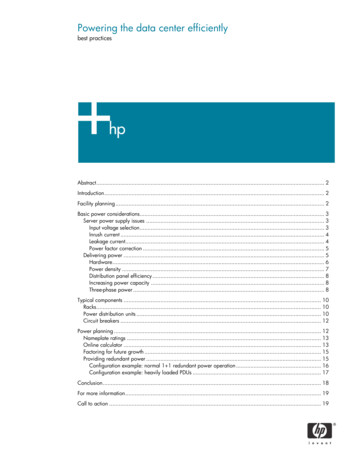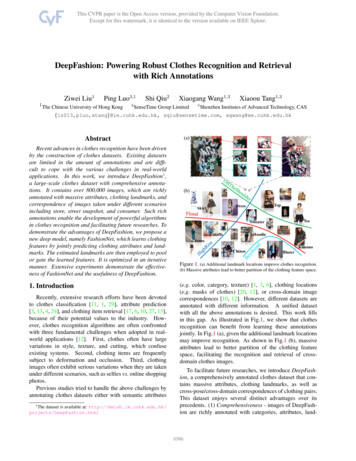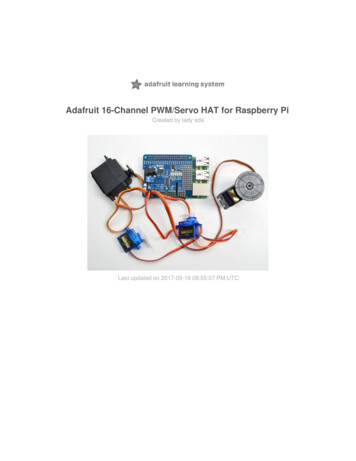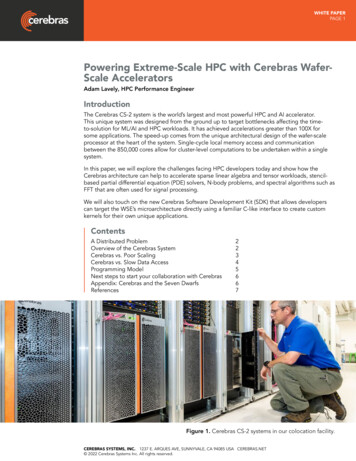
Transcription
Powering the data center efficientlybest practicesAbstract. 2Introduction. 2Facility planning . 2Basic power considerations. 3Server power supply issues . 3Input voltage selection. 3Inrush current . 4Leakage current. 4Power factor correction . 5Delivering power . 5Hardware. 6Power density . 7Distribution panel efficiency . 8Increasing power capacity . 8Three-phase power . 8Typical components . 10Racks. 10Power distribution units . 10Circuit breakers . 12Power planning . 12Nameplate ratings . 13Online calculator . 13Factoring for future growth . 15Providing redundant power . 15Configuration example: normal 1 1 redundant power operation . 16Configuration example: heavily loaded PDUs . 17Conclusion. 18For more information. 19Call to action . 19
AbstractIn today’s rapidly evolving information technology (IT) environment, facility power planning isbecoming more critical. This paper will explain trends in power requirements, and it will explain basicconsiderations of data center power. The paper will describe methods for calculating powerrequirements and how to use those requirements to select an appropriate power distributionconfiguration. This paper will also communicate best practices for using certain power products inconjunction with ProLiant servers and rack products.IntroductionAs server density grows, power requirements continue to increase. Today’s data centers can pushpower requirements to as much as 300 watts (W) per square foot. A typical 42U 1 cabinet withservers and storage requires 5 to 8 kilowatts (kW) of load, and today’s high-density servers andblades can push this to 12 to 14 kW and even peak as high as 20 kW.In addition, cable management is becoming a key issue, driven by high-density servers withredundant power supplies. High-density, 1-U servers with redundant power supplies can require asmany as 84 power cords in a single rack. As server power consumption continues to rise, powerdistribution unit (PDU) designs will also track higher current demands of redundantly powered servers.To support this rapidly evolving environment, facility power distribution planning requirements arebecoming more critical. However, determining true power needs is often confusing. A thoroughunderstanding of the following will reduce the confusion: Facility planning Basic power considerations Details of typical power components and their installation Power planning Cable management solutionsFacility planningSuccessful installations and implementations require careful, coordinated planning. Customers shouldask themselves the following questions about their data center: Have I engaged facility engineering in planning for hardware deployments and future growth? Have I adequately planned for growth in power and heat density? Is my data center configured to efficiently provide sufficient airflow to the new servers and storageproducts?When facilities engineers are involved early and often in the expansion and build out of a datacenter, risk is minimized and success is maximized. Site preparation has been a standard practice inthe mainframe and storage solution environments, now, PC server data centers need to adopt it asstandard practice. Although customers own and manage their environments, HP has professionalservices that can help configure their environment to meet their needs and to operate as efficiently aspossible.A U is a standard unit of measure for designating the height in computer enclosures and rack cabinets. A U equals 1.75 inches. For example, a4U chassis is 7 inches high. A 40U rack cabinet is 70 inches high.12
Basic power considerationsWhen planning an installation, customers must make a few decisions as well as be aware of a fewknown power supply issues regarding the delivery of power.Server power supply issuesInput voltage, power factor, inrush current, and leakage current are power supply issues that must beconsidered to provide safe and efficient power to data center equipment. As a standard feature, allProLiant power supplies are power-factor-corrected. This eliminates one of these issues and providesfor efficient operation.Input voltage selectionWhile this is not a choice in much of the world, the selection of the proper input voltage is a veryimportant issue in the Americas and other regions around the world that follow the North Americancommercial wiring practices. Choosing between low-voltage (LV) operation and high-voltage (HV)operation will have an effect on these areas: power supply output capacity, power conversionefficiency, power supply thermal operation, and finally, power supply reliability.HP defines LV as 100 to 120 VAC and HV as 200 to 240 VAC. In North America, commercialpower is delivered to the server at 120 V or 208 V. All HP servers now have auto-sensing inputcircuitry that automatically adjusts to the applied input voltage. The only exceptions are those devicesthat are defined as HV operation only. Make sure to always review a device’s input specificationsprior to connecting them to the power distribution system.Some ProLiant servers are equipped with power supplies that have greater capacity when connectedto HV input power. When heavily loaded, these products may require HV operation or the addition ofanother power supply in order to have fully redundant operation. The primary cause for the differenceis the limitation of the input devices in the power supply. Components such as the input receptacle,input fuses, and input filter components are many times limited to 10 Amps of maximum input current.For a given output power, a power supply operating at LV effectively has double the input currentwhen compared to HV operation. To achieve maximum output power at LV, the input current wouldexceed the rating of the input currents.Power supplies operate more efficiently when operating at HV. The typical server switch-mode powersupply has an efficiency rating between 65 percent and 80 percent. Some special-purpose productscan hit 90 percent efficiency. Operating at LV causes the power supply to operate at the lower end ofthis range. At 65 percent efficiency, 35 out of every 100 W pulled from the utility will be wasted bythe power supply. In a large data center, this lower efficiency can waste many kilowatt hours anddrive electrical bills higher with no benefit. In fact, there are many more negative effects.Power supply thermal operation is also effected by the choice of input voltage. The input componentspreviously mentioned above actually run hotter when operating with LV input power. This is caused bythe almost double input current. The formula for heat generated in a component is I2 x R, where I isthe input current and R is the resistance of the component. Therefore, if the input current is doubled,the heat generated in any given component is going to be four times higher. The life of a componentis significantly shortened when it continuously runs at higher temperatures. Therefore, there is anoverall impact on the life expectancy of the supply.3
Inrush currentElectronic devices containing solid-state power supplies experience an input current during initialstart-up that can be several times greater than their operating current. High current surge during startup, referred to as inrush current, can affect electrical systems by tripping fuses and circuit breakersunnecessarily.Inrush current is determined using theoretical worst-case measurements. Server specificationsdesignate the amount of inrush current that can be tolerated by the server. For example, thespecification for the ProLiant DL380 G2 server is 50 amperes (A or amp) per power supply for amaximum of 2 milliseconds (ms). Typical inrush events that occur in the real world last far less than2 ms. Inrush current of individual servers is not problematic; however, inrush current is additive andmulti-server implementations can easily surpass 50 A, however, for a very short period of time.Given the number of servers in a data center, power supplies must contain inrush current surgeprotection to limit the current drawn during startup. If the power supply does not use current surgeprotection, relays and fuses must be rated higher than any possible surge current. Server powersupplies currently offered by HP provide the capability to limit active inrush current. Circuitry in thefront end of the power supply limits the amount of current drawn by the power supply during theinitial period when alternating current (AC) power is applied.In addition, HP rack-mount PDU load segments are sized to minimize the effects of short-circuit currentand overload current events within the rack. Under normal operating conditions, the load segmentbreakers should isolate fault currents and prevent them from taking down the entire load connected tothe PDU. Breakers capable of withstanding hundreds of amps of inrush current would not provide theprotection needed under normal conditions; all the fault current would be passed directly to the ACmains distribution system and could affect more than just the rack involved. However, the breakerswill pass relatively large amounts of current for extremely short periods of time.HP recommends two practices to mitigate the effects of inrush current: Install additional PDUs in each rack to distribute and dilute the effect of the inrush current whenpower is applied to the rack. Ensure that the circuit breakers feeding these PDUs are suitably ratedfor the duty they will see. In most of the European Union, HP recommends the use of Type Dbreakers. Use an orderly shut-down and start-up procedure that applies power only to a portion of theequipment in the rack when power is restored. Once the initial load is energized, energize thepower to the remainder of the load in the rack. This procedure can be accomplished either byunplugging the power cords to a portion of the load or by opening one of the load segmentbreakers on the PDU.Leakage currentEarth leakage current is created by filter capacitors located between the primary circuits and theprimary grounding (earthing) conductor and subsequently the chassis of the computer. The current ismeasured from the accessible parts of the equipment back to the phase and neutral conductors. Undernormal operating conditions, leakage current does not create a hazard. Because the current isadditive when several pieces of equipment are connected together to the same source (for example,an uninterruptible power supply or PDU), the level of leakage current can reach a hazardous potentialquickly. If the primary ground or earthing conductor becomes open for any reason, the leakagecurrent and all of its potential will become available on any conductive (metal) surface of theequipment. If an individual comes in contact with the chassis of the equipment and ground, electricshock can occur.Leakage current can be problematic when the building’s installation is required to install residualground current fault detectors. These devices are set to trip open a circuit breaker when the leakagecurrent exceeds a predetermined level. The United Kingdom is one region where this can be an issue.4
For proper operation and safety, the equipment must be properly grounded. In the United States,install the equipment in accordance with National Fire Protection Association (NFPA) 70-1999National Electric Code (NEC) Article 250 as well as any local and regional building codes. InCanada, install the equipment in accordance with Canadian Standards Association, CSA C22.1,Canadian Electrical Code. In all other countries, install the equipment according to any regional ornational electrical wiring codes such as the International Electrotechnical Commission (IEC) 364 parts1 through 7. Furthermore, ensure that all power distribution devices used in the installation—such asbranch wiring and receptacles—are listed or certified grounding-type devices.Because of the high ground-leakage currents associated with multiple servers connected to the samepower source, a reliable grounded (earthed) connection is essential before applying power to thesystem. HP recommends the use of a PDU that is either permanently wired to the building’s branchcircuit or features a nondetachable cord that is wired to an industrial style plug. National ElectricalManufacturers Association (NEMA) locking-style plugs or those complying with IEC 60309 areconsidered suitable for this purpose.Power factor correctionBefore computing and storage devices can use electrical power, the AC provided from the sourcemust be transformed to direct current (DC) by a power supply. The term “power” is the rate at whichthe electricity does work, such as running a central processing unit (CPU) or turning a cooling fan. Thepower that the electricity provides (apparent power) is simply the voltage times the current, measuredin volt-amperes (VA).There is a difference between the power supplied to a device and the power actually used by thedevice because of the capacitive nature at the input of the device to delay current flow. The truepower used by the load is measured in watts.The power factor (PF) of a device is a number between zero and one that represents the ratiobetween the apparent power in VA and the real power in Watts or, in other words, how efficientlythe current is converted to useful work. A power supply that has a PF of 1.0 indicates that the voltageand current peak together, which results in the most efficient loading of the device.Power supplies for servers usually contain circuitry to “correct” the power factor (that is, to bring inputcurrent and voltage into phase). Power-factor correction allows the input current to continuously flow,reduces the peak input current, and reduces the energy loss in the power supply, thus improving itsoperation efficiency. Power-factor-corrected (PFC) power supplies have a power factor nearunity ( 1), and thus are highly efficient. The use of energy-efficient PFC devices, includinguninterruptible power supplies (UPSs), can lead to significant cost savings.Delivering powerAs ProLiant servers have evolved from their origin as personal computer (PC) servers to data centerservers, the long-held assumption that a 120-V, 10-A power cord should be sufficient to poweranything in the data center has become invalid.Also invalid is the assumption that an open receptacle indicates available unlimited power—like blankchecks in a checkbook. Just as blank checks do not indicate unlimited money supply, openreceptacles do not indicate unlimited power supply. For example, a 24-A PDU with 32 receptaclescan power only three ProLiant DL580 G2 servers because each requires 8 A.To provide more power to a rack efficiently, the paradigm of using 15- to 20-A branches must bebroken. In North America, this is the standard branch circuit that an electrician will run off the maindistribution board. Some options include 30-A branches, which are becoming standard, and threephase branches, which are coming very rapidly.5
HardwareMore power requires larger hardware—plugs and wires have to change from the PC line cord.Figure 1 shows two plugs common in HP products, and Figure 2 shows the larger wiring of theseplugs.Figure 1. Common plugs.Figure 2. Large wiring in common plugs.NEMA L6-30P,208 V, 30 A, 3 wLarger copper cablingSJ/SO 3 x 10awgSJ/SO 4 x 10awgNEMA L15-30P,208 V, 30 A 3 ph, 4 wThe industry uses two primary connector standards: NEMA and IEC.North America uses the NEMA standard. The L in front indicates a locking or twist-lock connection.The absence of L indicates a standard push-in plug. The 5 or 6 following that is the voltage rating ofthe plug. A 5 indicates a rating up to 125 V; a 6 indicates a rating up to 250 V. The 15, 20, or 30is the rated current in amperes. P and R stand for plug and receptacle, respectively. In the case of thetop common plug shown in Figure 1, the designation NEMA L6-30P indicates a locking plug rated forup to 250 V and 30 A.The other primary standard is the IEC standard. The IEC is a standards body in Geneva, Switzerlandthat defines the most common connectors: the IEC 320 general-purpose household connectors and theIEC 309 industrial-grade connectors. The C13/C14 connectors are the 10-A power supplyconnectors used on 90 percent of HP equipment. With all IEC 320 connectors, females (receptacles)have odd numbers; males (plugs) have even numbers. The C19/C20 connectors are rated for 16 A.Larger or higher power devices may require C19/C20 connectors if the input can exceed the 10-Arange. One example is the ProLiant DL580 G2 server.Inside a rack, only two connectors are used for distributing power: Those are the NEMA 5-15 for lowvoltage, 120-V, applications, and the IEC 320, C13/C14.6
IEC 309 pin-and-sleeve connectors are commonly used on international PDUs, servers, and storagedevices, and they are beginning to be used in North America. Figure 3 shows three types of IEC 309pin-and-sleeve connectors, all rated at 250 V, that are becoming more popular in the United States: 16-A single-phase 32-A single-phase 32-A three-phaseFigure 3. IEC 309 pin-and-sleeve connectors.Power densityFrom an electrical supply standpoint, deploying full racks of servers can be problematic. The total rackload is not the problem. Rather, the issue lies with how power is distributed—the relationship betweenand restrictions on the line cords and distribution outlet. For example, the 250-V rating on a plug isjust its maximum voltage, not the rating of the circuit behind it. Table 1 shows power limitationsassociated with each common type of branch circuit in North America.Table 1. Commercial branch circuits in North America.Branch voltageBranch circuit sizeMax load 80% per NECMaximum available power120 V20 A16 A1920 VA120 V30 A24 A2880 VA208 V20 A16 A3328 VA208 V30 A24 A4992 VA208 V20 A 3Ø27 A5760 VA208 V30 A 3Ø42 A8650 VAIn North America, the standard distribution to the data center is 208 V. Distributions of 220/221 V(sometimes also referred to as 230/240 V) do not occur in commercial power distribution in NorthAmerica. Since everything runs off of 208 V, it is not necessary to install transformers to convert208 V to 220 V.As shown in Table 1, a 120-V, 30-A circuit is limited to less than 3,000 VA, or 3,000 watts ofpower. The same size wire at 208 V, 30 A can deliver almost 5,000 watts, or 5,000 VA. However,even 5,000 VA is becoming a limitation with racks that are very heavily loaded. Today’s powerdensities dictate leaving the 120-V infrastructure, using multiple 208-V, 30-A feeds and lookingforward to using three-phase power to meet the density demands.7
Distribution panel efficiencyThe distribution panel is key—how power is pulled out of the panel determines how efficiently thatpower is used. In most cases, more power is left in the panel than is used on the floor.The problem is the number of poles or attach points in the panel. A standard power distribution panelfor a data center will provide approximately 150,000 VA with 84 poles. A 208-V distributionrequires two poles, which allows 42 two-pole positions out of the distribution panel. As a result,power appears plentiful. In actuality, distribution limitations leave power in the panel.For example, a cabinet full of 21 ProLiant DL380 G2 servers requires 8,560 VA to operate. A 24-APDU at 208 V is limited to about 5,000 VA. Consequently, the load requires at least two 24-A PDUs.Redundancy requires four PDUs. Since each PDU requires two poles off the distribution panel to get208 V, each cabinet requires four breakers and eight poles. With these requirements, the 84-polepanel will provide redundant power for 10 cabinets and 210 servers using today’s distributionmethod. A 10-cabinet implementation will use only 86,000 VA of the 150,000 VA possible from thepanel. Since there are not enough poles to pull additional power, more than 40 percent of the totalavailable power is left at the panel.Increasing power capacityInstalling a larger current-density PDU is not a solution for the problem. The lack of cost-effective plugstandards above 30 A would require that larger single- and two-phase PDUs be hard wired into thedata center by an electrician.The only potential solution today is to move to three-phase power distribution. The NEMA L15-30P isa very common plug used for three-phase power.Three-phase powerAll electricity is generated and distributed by utilities as three-phase AC, usually at a voltage in excessof 150,000 V. By the time the power reaches a data center, its voltage has been stepped down to480 V or less.Three-phase current is represented by three separate single phases. The voltage of each phase isrepresented by a sinusoidal wave that alternates between positive and negative values (see Figure 4)at a frequency of 60 cycles per second (cps), or 50 cps in many European countries. The current ineach phase has a similar waveform at the same frequency.Figure 4. Representation of sinusoidal voltage waves of three-phase current and corresponding transformer phase windings.3-Phase Electrical CurrentTransformer WindingsPhase 1200/240VNeutralPhase 2-200/240V1Cycle2CyclesPhase 38
Most computer equipment operates on single-phase current. Single-phase loads, such as computerequipment, are connected to one of the transformer’s phase windings and the neutral connection.Equipment requiring more power, including data center environment support systems, runs on threephase current. Three-phase loads, such as air-conditioning equipment, are connected to all threetransformer windings.Larger systems are moving to higher amperage or three-phase power. Many enterprise-class machinespresently use three-phase power, and most data centers are already wired for three-phase power. Acommon and economical method of supplying power to high-density data centers is to use a 208-V,three-phase system, known as high-line AC power. The system operates with 208 V between any twotransformer windings, giving 120 V to neutral (Figure 5).Figure 5. High-line AC powerThree-phase power is typically more efficient than single-phase power since it provides more than150 percent of maximum available power provided by single-phase power. In addition, three-phasepower provides more power using smaller circuit sizes, which translates to smaller cables forcustomers. Since power density goes from 5,000 VA to 8,600 VA, 24 A to 42 A, fewer overall panelpositions are used for rack implementations. Three-phase power is also more stable than single-phasepower since it has three voltage waves and is at peak voltage more of the time. Table 2 comparessingle-phase, two-phase, and three-phase power distributions and illustrates the increased efficiency ofthree-phase power.Table 2. Panel utilization for racks of ProLiant DL380 G2 servers.PDU model24A 1-phase PDU, 120 V24A 2-phase PDU, 208 V24A 3-phase PDU, 208 VVA per PDU288049928650PDUs per rack of 21ProLiant DL380 G2 servers842Breaker poles required perrack8 (1 poles per PDU)8 (2 poles per PDU)6 (3 poles per PDU)Racks per 84-poledistribution panel101014Total VA used from panel89,46086,730121,4229
While the best setup for a data center application depends upon the particular facility requirements,HP recommends that rack-optimized equipment be installed for operating at high-line voltage for thefollowing reasons: A single cabinet can provide greater capacity. For the same size circuit, almost twice the powercan be delivered to a rack at high-line power than at low-line power. For example, a 120-V, 30-Abranch circuit can deliver 2,880 VA to a rack, while a 208-V, 30-A branch can deliver 4,992 VAto a rack. The amount of infrastructure (for example, the number of PDUs and the number of circuits pulledfrom the panel) can be halved. Some products require 200-V to 240-V input power to operate at their full rated capacity. Power supply efficiency is higher at higher voltage operation, which wastes less energy. Powerfactor is also higher with higher voltage input. Power supplies run cooler at higher input voltages and therefore will last longer and improveoverall availability.Typical componentsA well-designed electrical system for the data center ensures adequate and consistent power to thecomputer hardware and reduces the risk of failures at every point in the system. Adequate andconsistent power can be provided with a combination of components, including: Racks Power distribution units Circuit breakersRacksRacks range from 70 to 87 inches (1.8 to 2.2 meters) in height, which means they can hold from six8U servers to forty-two 1U servers, not including storage or UPSs. A typical 42U cabinet with dualprocessor (2P) servers and storage requires over 12 kW of power. IA64 servers and higher capacitydrives may increase the power requirement to 15 kW per rack.Providing adequate and consistent power to racks of equipment can be challenging. For example,cabling for a rack full of equipment can be troublesome. HP has developed racks and rack optionsthat help to alleviate many of the challenges associated with powering racks of servers. For example,many racks now provide extra room for cables and space for mounting 0U products like the 0Upower distribution unit.Power distribution unitsIn traditional data centers, power goes from the transformers to a number of sub-panels that containcircuit breakers. A wire from each circuit breaker provides power to each outlet where the equipmentis connected. As long as the power provided is sufficient for the equipment in place, this system isadequate. However, if the outlets, wire, and breakers need to be upgraded for higher amperage orthree-phase power, the process can be very expensive and time consuming. As a result, HPrecommends using PDUs in installations where a number of server units can place serious loadingdemands on the AC power bus.HP modular PDUs integrate the outlets, wire, and breakers in a convenient location on each rack ofequipment. HP modular PDUs range from 16 A to 40 A, with up to 32 outlet receptacles. For missioncritical environments with redundant power systems, HP also offers a fault-tolerant dual input PDU thatautomatically switches over to a secondary input source if the first source fails.10
With so many components in every rack, cable management is becoming increasingly important. TheHP modular PDU provides an excellent cable management solution. The PDU is split into two pieces: A control core connects to the power bus (or to a UPS), brings the high-amperage conductor intothe rack, and splits it up across the breakers. The control core includes a 15-A circuit brea
many as 84 power cords in a single rack. As server power consumption continues to rise, power distribution unit (PDU) designs will also track higher current demands of redundantly powered servers. To support this rapidly evolving environment, facility power distribution planning requirements are becoming more critical.











